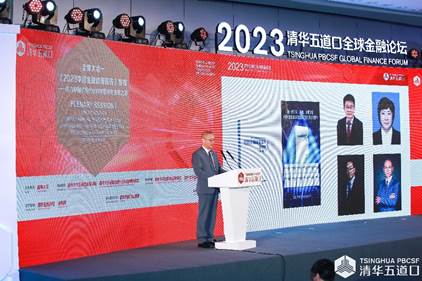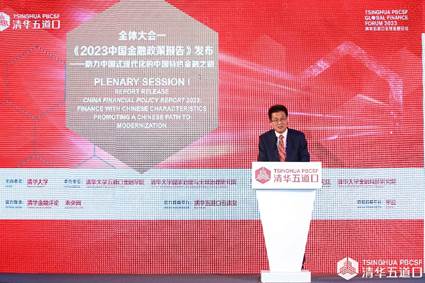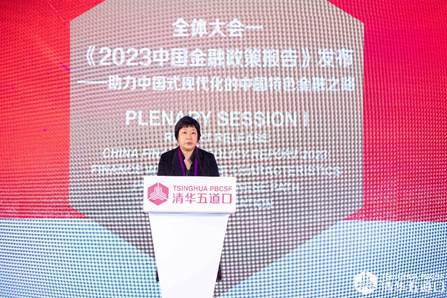On May 20, 2023, the "Tsinghua PBCSF Global Finance Forum" convened under the theme "Bolster Confidence, High-Quality Financial Development to Serve Chinese Modernization". The conference released the "China Financial Policy Report 2023" (hereinafter referred to as the "Report"), which summarizes the policy practice experience of China's financial sector since last year and provides a forecast for the future financial landscape and development. This year's report is centered on “finance with Chinese characteristics promoting a Chinese path to modernization”.The report release was the major theme of the plenary session I, where renowned scholars and industry experts are invited. The session was chaired by He Haifeng, the executive editor of the Report and chief economist of Guotai Junan Securities Co., Ltd.

(He Haifeng, Chief Economist of Guotai Junan Securities)
Adhering to the mission and principle of "rooting in China, and connecting the world," the "China Financial Policy Report" is jointly composed by the PBC School of Finance, Tsinghua University, and the Financial Policy Research Center of the Chinese Academy of Social Sciences. The aim is to reflect comprehensively and accurately the significant annual themes and policy dynamics in China's financial policy sector and to strive to convey an accurate picture of China's financial development and the comprehensive impact of China's financial policy.
Ding Zhijie, executive director of the Report and director of the Foreign Exchange Research Center of the State Administration of Foreign Exchange, released the China Financial Policy Report 2023 and introduced the main research of the report. Ding Zhijie pointed out that this year's theme is not only a reflection of the latest achievements in learning and understanding China’s national development strategy, also summarizing China's exploration in the financial industry in the new era. He introduced that it involves four aspects of overall planning: 1. balancing the relationship between finance and the economy; 2. balancing the demand and supply of finance; 3. balancing the relationship between openness and stability; and 4. balancing development and security.

(Ding Zhijie, Director, Foreign Exchange Research Center, State Administration of Foreign Exchange)
The report states that in 2022, China's financial services have made new progress in the real economy: 1.a modern central banking system has been built. The central bank guided the financial industry to targeted support for the development of the real economy through a series of innovative policy tools, such as differentiated reserve ratio and credit policies, as well as interest rate cuts last year; 2. China has deepened the supply-side structural reforms in finance - a all-round, multi-level financial system, such as credit market, bond market, stock market, and venture capital sector, have become more robust; 3. China has created a high-level opening-up in the financial industry, sticking to promoting institutional opening-up in-depth; 4. the modern financial regulatory system has been further strengthened and improved. Several important regulatory documents were issued in 2022, and the legal system in the financial sector has been continually improved.
Ding Zhijie pointed out there is the high uncertainty of current external environment for economic operation. On the one hand, developed countries, especially in the West, are once again facing the dilemma of price stability and financial stability. On the other hand, the imbalance between the U.S., the European countries, and the peripheral developing countries is more prominent. The rapid increase in the U.S. interest rate puts pressure on the monetary and financial systems of emerging market economies on the periphery. Although China's short-term economic recovery faces some challenges from the domestic economic situation, there are favorable conditions for high-quality economic development. First, China's super-large-scale market economy system has strong resilience. China's economy has developed steadily since 2012, while its economic structure has continued to optimize. In 2022, the value-added of the manufacturing industry accounted for nearly 30% of the global share. Second, China has conducted independent macro-prudential monetary policy. Finally, China's balance of payments and foreign exchange operation is stable, and the flexibility of two-way RMB exchange rate movement has increased.
In response to new situations and challenges, the Report suggests: 1. to construct a macro regulation system with Chinese characteristics. The central bank should coordinate the relationship between price stability, employment stability, and financial stability, combining policies' effectiveness with stimulating business entities' vitality; 2. to strengthen and improve the modern financial regulatory system with Chinese characteristics. As the crisis transmission speeds up in the information age, regulatory departments need to increase the rate of information processing and reaction and identify risks based on real-time data; 3. to improve the function of the capital market. The comprehensive implementation of the registration-based IPO system marks a milestone in the reform and development of China's capital market. It is necessary to further deepen the supply-side structural reform of finance following the principles of marketization, legalization, and internationalization; 4. to accelerate financial technology empowerment by encouraging financial institutions' digital transformation, balancing innovation with risk control, and promoting the new stage of China’s financial technology from "building columns and beams" to "accumulating momentum”; 5. to improve the green finance system and effectively connect green finance and transition finance; 6. to further open up the financial markets with high standards. For example, to expand the opening and entry-level of China's foreign exchange and financial markets, support qualified free trade pilot zones and free trade ports to connect with international high-standard trade and economic rules, and orderly promote RMB internationalization.
After the report's release, Yu Hua, president and secretary of the Party Committee of the Insurance Association of China, and Yang Jichuan, executive president of Sanya International Asset Exchange, gave keynote speeches.
Insurance Industry Serving a Chinese Path to Modernization

(Yu Hua, President and Secretary of the Party Committee, Insurance Association of China)
In her speech titled "Insurance Industry Serving a Chinese Path to Modernization," Yu Hua emphasized the remarkable progress made by the insurance sector in recent years. She highlighted four specific areas where the insurance industry's service quality has significantly improved: 1. the protective function of insurance has notably increased, providing businesses and individuals with more robust financial safeguards; 2. the insurance industry has made evident progress in serving people's livelihoods, offering a more comprehensive range of insurance products and services to meet the diverse needs of consumers; 3. the insurance industry's role in social governance has been comprehensively advanced; 4. the insurance sector's role in providing financing is becoming prominent, playing a unique advantage in serving a Chinese path to modernization.
Yu Hua emphasized that in the new era and the new journey, the insurance industry should adhere to the national development strategy, and she outlined four areas for further industry improvement: 1. to focus on promoting high-quality development and accelerating the innovation of insurance products; 2. to implement the concept of inclusive finance by adhering to the need for people to live a better life; 3. to actively serve the social governance system, vigorously develop insurance products such as agricultural insurance, commercial health insurance, commercial pension insurance, liability insurance, and catastrophe insurance; 4. to effectively manage risk prevention and control in key areas and firmly preventing systemic financial risks.
Existing Issues and Solutions for Credit Capital Market

(Yang Jichuan, Executive President of Sanya International Asset Exchange)
In the speech titled "Existing Issues and Solutions for Credit Capital Market," Yang Jichuan pointed out four main issues that the Chinese capital market faces in serving the high-quality economic development: slow development of the credit capital market, lack of bank loan trading market, inadequate asset securitization market, and the immature institutional buyer market.
Yang Jichuan proposed solutions, drawing on his learning of mature international markets, and his proposal to build a financial asset and debt capital trading market in the Hainan Free Trade Port: 1. to focus on developing the local financial system by improving regulatory policies and enriching the supplies of products; 2. to build an asset trading market in Hainan Free Trade Port, constructing the ”Hainan-Hong Kong Stock Connect program – Qiong Gang Tong (Similar to Shanghai-Hong Kong Stock Connect program) to serve as a cross-border trading platform system that connects "non-standard assets, commercialization/securitization, insurance" markets in both areas. Simultaneously, to construct the bond market in Hainan Free Trade Port to issue credit-based products to domestic and foreign investors; 3. to strengthen the link between domestic and foreign markets based on macro-prudential policies and achieve a high-level institutional capital market opening.